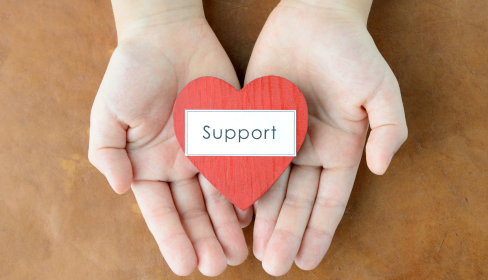Toxic Behavior Examples: What Toxic Behavior Is… and How to Deal With It
Published By Justin Baksh, LMHC, MCAP
March 22, 2024

Sarah and Michael and their two children live with Michael’s mother, Linda. Linda had to move in a few years due to her financial struggles and declining health. While Sarah and Michael initially welcomed Linda with open arms, hoping to support her, they have increasingly found themselves navigating a challenging environment marked by Linda’s toxic behaviors. There are many examples of this behavior displayed on a daily basis in their home.
For one, Linda often criticizes Sarah’s parenting style and household management, openly questioning her decisions and competence in front of the children. “You’re not doing it right,” Linda says frequently, whether it is about Sarah’s cooking or how she cleans the house. This constant criticism leaves Sarah feeling undermined, doubting her abilities as a mother and a partner, leading to a decline in her self-esteem.
Linda also manipulates emotions to get her way, especially with Michael. She plays the victim, claiming she’s always left out and that nobody cares about her, which makes Michael feel guilty. This guilt-tripping forces Michael to side with his mother in disputes, straining his relationship with Sarah and causing tension in the marriage.
Finally, Linda’s behavior reflects a lack of respect for personal boundaries. She enters Sarah and Michael’s bedroom without knocking, rummages through their mail, and listens in on private conversations. This invasion of privacy makes the family feel like they have no personal space or autonomy, contributing to a suffocating atmosphere in the home.
Linda’s toxic behavior creates an environment of constant stress and discomfort. Sarah feels belittled and disrespected, struggling with feelings of inadequacy. Michael is torn between his mother and his wife, leading to feelings of guilt and frustration. The tension affects the emotional wellbeing of the children and undermines their sense of security. The family dynamic is characterized by a lack of harmony and mutual respect, making the home a source of anxiety rather than a safe haven.
The situation Sarah and Michael find themselves in with Linda highlights the profound impact that toxic behaviors can have on family dynamics and personal wellbeing.
What is Toxic Behavior?
Toxic behavior is characterized by actions and attitudes that harm or manipulate others. It can infiltrate the closest of relationships, creating an environment of stress, discomfort, and emotional turmoil.
It’s not confined to personal relationships either. Toxic behavior is alive and well in the workplace, with A recent Fortune poll found that most of us, or 64 percent, have experienced a toxic work environment. The most often cited toxic behavior is a lack of respect, with 55 percent indicating that had run up against it on the job.
Recognizing toxic behaviors is not just an exercise in labeling, but a crucial step towards safeguarding one’s mental health and nurturing healthier relationships. It emphasizes the importance of understanding what makes behavior toxic, not to cast judgment, but to empower individuals to identify and address the negative influences in their lives.
Toxic Behavior Examples
Emotional manipulation is a subtle yet insidious form of toxic behavior where an individual seeks to control or influence others through deceptive or underhanded tactics. It’s a psychological strategy used to exploit the vulnerabilities of others, often leaving the victim feeling confused, powerless, and questioning their own reality. Recognizing emotional manipulation is crucial for maintaining one’s mental health and ensuring healthy, respectful relationships.

Gaslighting
Gaslighting involves the manipulator denying or twisting facts to make the victim doubt their own memory, perception, or sanity. For instance, if a person consistently dismisses your concerns by saying, “You’re overreacting,” or “That never happened,” they might be gaslighting you.

Guilt-Tripping
Manipulators often use guilt to control others, making them feel responsible for the manipulator’s emotions or circumstances. A common example is a parent telling their child, “After all I’ve sacrificed for you, you owe me this.”

Passive-Aggressive Behavior
This is a sneaky, sideways way of expressing negative feelings without directly addressing them. An example includes a coworker who is upset with you but instead of discussing it, they leave snide notes or deliberately exclude you from important emails.

Silent Treatment
By withdrawing and refusing to communicate, manipulators punish the victim for perceived slights, controlling them through the fear of abandonment or rejection. The silent treatment can leave you wondering what happened and how to “fix” it.

Playing the Victim
Manipulators often portray themselves as the injured party to gain sympathy and manipulate situations in their favor, sidestepping accountability. They are playing the situation to get what they want, despite the consequences to you or anyone else.
Signs You’ve Been Exposed to Toxic Behavior
Another way to tell if you are experiencing toxic behavior from an individual (or group of individuals) is to take stock of your own feelings. They can be a good barometer of what is happening, before you fully realize it.

Frequent Feelings of Confusion
Constantly questioning your actions, feelings, or decisions around a particular person can indicate manipulation. Scouring every word and action of a interaction with someone can be an indication that that person is toxic for you.

Walking on Eggshells
Feeling afraid to speak up or express your needs due to fear of retaliation or negative consequences is a red flag. You may feel as though you are walking on eggshells, worried about saying or doing the wrong thing… and setting off the person in question.

Emotional Exhaustion
Relationships that leave you feeling drained, depressed, or anxious may involve emotional manipulation. You may feel the need to withdraw or seek comfort in other people after being exposed to toxic behavior.

Diminished Self-Worth
If interaction with someone regularly leads to self-doubt or a decreased sense of self-worth, it may be time to reassess the relationship. Criticism, snarky comments, belittling behavior… all of this is a sign of toxic behavior, which can result in an eroded sense of self-work and even lead to the development of anxiety and depression.

Unequal Give-and-Take
Healthy relationships involve an equal give-and take over time. However, if you are always the one making concessions or sacrifices, it can be indicative of manipulation and toxic behavior. This unhealthy relationship dynamic can amplify feelings of low self-worth and depletion.
Recognizing these toxic behaviors and signs is the first step toward addressing and distancing oneself from emotionally manipulative situations. It is vital to always trust your feelings and find support if you feel manipulated. Consulting a mental health professional can provide strategies for dealing with manipulative behaviors and help reinforce boundaries that protect your emotional wellbeing.
Dealing with Toxic Behaviors: Strategies for Empowerment and Wellbeing
Navigating relationships that involve toxic behaviors requires a thoughtful approach centered on self-preservation, clear communication, and personal growth. Here’s how to address and manage these challenging dynamics effectively.

Setting Boundaries
Boundaries serve as the cornerstone of all healthy relationships, outlining how you expect to be treated and what you will not tolerate. It’s crucial to recognize your personal limits and convey them explicitly to the person demonstrating toxic behavior. Maintain a steadfast and consistent approach in upholding these boundaries, even if it results in challenging or awkward situations. If a family member habitually criticizes your life choices, you might say, “I value your concern, but I need you to respect my decisions and not comment negatively on them.”

Communication Strategies
Effective communication is key to addressing toxic behaviors directly and constructively. Instead of accusing or blaming the person, use “I” statements to explain how their actions affect you. Aim for a calm and clear dialogue that seeks mutual understanding rather than conflict. For example, “I feel hurt and undervalued when my opinions are dismissed during discussions. I would appreciate it if my viewpoints were considered with respect.”

Seeking Support
Dealing with toxicity can be isolating and overwhelming, making external support crucial for your mental health. Seek support from reliable friends, family members, or mental health experts who can offer insight, affirmation, and guidance. Participating in support groups, whether face-to-face or through online platforms, can also provide comfort and techniques for managing your situation.

Self-Care and Emotional Wellbeing
It’s essential to focus on your mental and physical health while dealing with the pressures of toxic behaviors. Dedicate time to activities that rejuvenate both your mind and body, like working out, practicing meditation, pursuing hobbies, or enjoying the outdoors. Recognize when you need a break and allow yourself time to recharge. Implementing a daily self-care routine, including mindfulness practices and physical activity, can help mitigate the emotional toll of dealing with toxicity.

Decision-Making
Sometimes, the healthiest option may be to reevaluate the viability of maintaining the relationship. Should the situation severely impact your wellbeing and fail improve despite attempts to resolve issues, think about reducing your involvement or terminating the relationship or the job altogether. After repeated attempts to address toxic behavior and seeing no improvement, you might decide that limiting contact or ending the friendship is necessary for your mental health.
Utilizing these approaches allows you to tackle such difficulties with resilience and honesty, cultivating healthier interactions and enhancing your overall life quality. Keep in mind, seeking professional assistance to guide you through this journey is perfectly acceptable, ensuring you have the necessary support at every stage.
As for Michael and Sarah, they made the difficult decision to find Linda an alternative place to live, prioritizing the health and harmony of their family unit.
What’s Behind Toxic Behavior?
Toxic behavior can be caused by a variety of things, including genetically inherited personality traits, mental disorders, childhood trauma or the way they were raised.
For example, borderline personality disorder can lead to behaviors that make others feel as though they are walking on eggshells. People with one of the dark triad personality traits – narcissism, psychopathy and Machiavellianism – can behave in a way that is hurtful to others, and research indicates that these traits can be inherited. Those who were praised excessively as a child or, on the opposite end of the spectrum, were neglected, abandoned or abused, can display toxic behaviors as an adult.
The thing is, you need to focus on creating a healthy environment for yourself. Trying to figure out why a person does what they do can be a pointless endeavor. Even more futile is attempting to change or convince someone to change or behave differently toward you.
The Bottom Line on Toxic Behavior
It is vital to take decisive action in toxic situations. Enduring such behavior is not an obligation. Removing oneself from harmful environments or relationships is a form of self-respect, enabling you to live a healthier, more positive life. Doing so may require difficult decisions and changes, but it is a testament to the strength and resilience within us all to seek better, more respectful, and loving interactions.
Remember, taking control of your situation, seeking professional guidance, and making choices for your wellbeing are essential steps toward a life free from toxicity and abuse.
- Dark Triad | Psychology Today. (n.d.). www.psychologytoday.com.
- Most employees say their workplaces are “toxic.” What if you’re the toxic one? (n.d.). Fortune.
- Schermer, J. A., & Jones, D. N. (2020). The behavioral genetics of the dark triad core versus unique trait components: A pilot study. Personality and Individual Differences, 154, 109701.
- Toxic exodus | McKinsey & Company. (n.d.). www.mckinsey.com.






